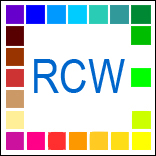This link page follows color from the element that is the color to the rock, mineral or oxide.
Crystal Real Color Wheel
http://www.realcolorwheel.com/crystal.htmColor and Elements in Color
Toward Color Theory
The colors yellow to red darken to brown, as they do in crystals of the yellow to red colors. Cyan darkens to ultramarine blue.
That would make yellow opposite ultramarine blue, as dark yellow (brown) and ultramarine blue mix neutral. As yellow moves toward red it's opposite color blue moves to cyan. Orange and Cobalt blue (between cyan and ultramarine blue) are opposits and make a better neutral than ultramarine blue and orange. Red is opposite cyan. This is my color theory and it matches the Real Color Wheel for Artists. Representing this theory in a solid double cone it is black in the middle without black pigment.
Don Jusko
P.S. The RGB colorwheel for computers gets dark by subtracting light, making a different set of internal colors that don't work for artists, never did. Elements make pigments, not light. Elements, Crystals and Pigments travel the same paths to dark.
Here I have chosen some of the many crystals that show what I am talking about.YELLOW TO BROWN CRYSTALS
RUTILE, TiO2, H6.5, SG-4,23, tetragonal crystal.
TITANIUM, red to brown and yellow to brown, colors centering to neutral dark. Just on the other side of the darkest center in the coloring wheel, brown is mixing with ultramarine blue and getting cooler, some of that blue color shows up. Titanium is the only element that can cross over the dark center in one crystal. Idiochromatic. Transparent, translucent and opaque in the same crystal. Purple rutile is also found in the Alps, idiochromatic.
TITANIUM, yellow to yellow-brown or red to red-brown, brown changes to a neutral dark by continued mixing with the opposite spectrum colors, ultramarine, azure and cyan. All idiochromatic within titanium.
CHRYSOBERLE, BeAl2O4, H8+, SG-3.74, orthorhombic crystal.
BERYLLIUM, standard yellow centering to brown crystal.
ORANGE TO BROWN CRYSTALS
GROSSULAR, Ca3Al2[SiO4]3, H7, SG-3.5, cubic, garnet group.
ALUMINUM, standard color orange, #2,[YYYM], yellow to orange, centering to brown, idiochromatic, transparent, CHROMIUM, green, allochromatic.
RED TO BROWN CRYSTALS
CINNABAR, HgS, H2, SG-8.09, sulphide of mercury ore.
MERCURY, red, standard color #3, [YYMM], opaque, vermilion-red to brown is the color scale for the masses, and transparent scarlet is the color for crystals. Cinnabar has internal coloring, idiochromatic coloring, because the color comes from the element that's crystallizing, in this case mercury, the liquid metal. The amorphous mass is crushed and used as the pigment vermilion, it's a heavy and a fast drier. Precious and rare.
CYAN TO BLUE CRYSTALS
AZURITE, Cu3[CO3]2[0H]2, H3.5, SG-3.7, monoclinic.
COPPER, Standard Azure color, #8, [MCCC]. Cyan-blue transparent to opaque, shows blue in mass. This was a popular ancient pigment color, crushed, rare. Copper Blue and lead white or vermilion will turn black, so there must be a painting isolation layer. It was usually applied with egg and varnished over and never mixed with other colors. The many hues and opacities of azurite ranging from an opaque ultramarine blue, cobalt blue to a opaque or transparent cyan, all effected by oil in a bad yellowing way.
CALCITE, CaCO3, H3 STANDARDMOHS', SG-2.7, trigonal crystals, also aggregate and mass, colorless, transparent to translucent.
COPPER, Iceland Spar, Cyan, allochromatic, polarizing filter, changes from cyan to ultramarine blue.
BERYL, Be3Al2[Si03]6, H7.5,SG-2.7, hexagonal crystal system.
BERYLLIUM element in Beryl crystal, cyan, yellow, idiochromatic.
ALUMINUM in beryl excepts a lot of foreign chromates, just as it does in the corundum and spodumene compounds, Here an aluminum light trick is found in aquamarine, light cyan is seen from one direction and deep ultramarine blue from a 90 degree off angle.
LABRACORITE, NaAlSi3O8-CaAl2Si2O8, H6, SG-2.5, sodium-aluminum series of plagioclase feldspars.
ALUMINUM, blue to cyan color plus an unusual effect called schiller, the inside glow of cyan color moves with you, playing off included lamellae minerals. Idiochromatic, opaque.
YELLOW TO BROWN TO BLUE CRYSTAL
WAVELLITE, Al3[PO4]2[OH,F]3.5H2O, H3.5, SG-2.36, orthorhombic crystal system, acicular, like the needles of Rutile suspended in clear crystal, only these needle crystals form a dense rocklike mass.
ALUMINUM, yellow, brown, blue, centering standard, transparent. Aluminum really does it big this time, each needle starts at the center radiating outward, concentrical ringed bands form around the center, each band ending as a cleavage line, twenty or so bands per complete needle crystal. The band itself can change from clear transparent to opaque white while at the center, the second band range is transparent yellow crystal, than brown, than blue. From brown to blue, this crystal can change into an aggregate and lose it's crystal properties.
THIS MINERAL PHOSPHATE SHOWS THE CENTERING OF YELLOW TO BROWN AND BROWN TO BLUE.
Get crystals here direct from the mines.
Crystals and stuff
Date: Fri, 11 Jan 2002
From: jim@krystalica.com
Organization: Krystalica

 Home
Home

 Help
Help

 Search
Search

 Login
Login

 Register
Register

 Broadcast Message to Admin(s)
Broadcast Message to Admin(s)

 « Home
« Home  ‹ Board
‹ Board  Top of this page
Top of this page 
 Pages: 1
Pages: 1

